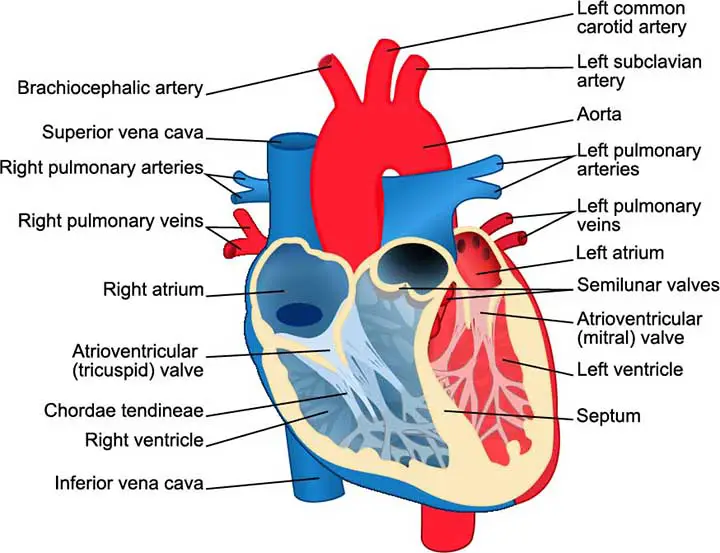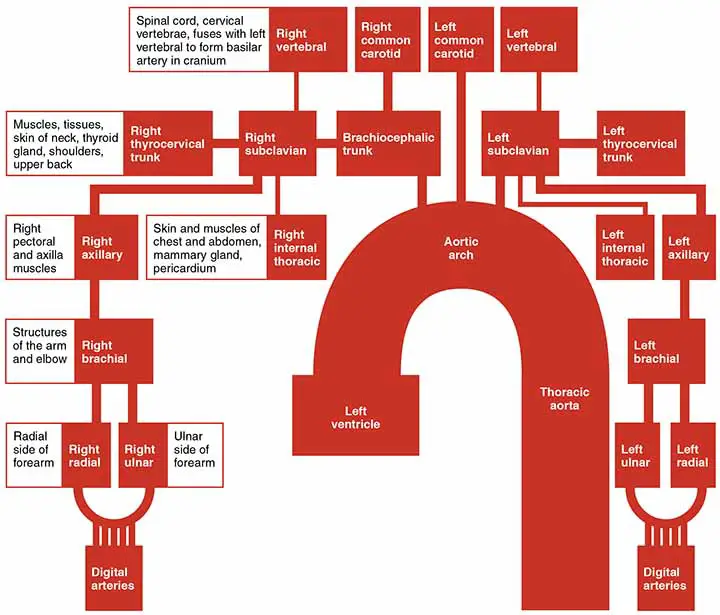Table of Contents
Brachiocephalic Trunk Overview
The brachiocephalic trunk (BCT) is a large vessel that supplies the head, neck, and right arm. It is also termed the brachiocephalic artery and was formerly known as the innominate artery.
The brachiocephalic trunk is the first of three major branches of the aortic arch to emerge from the upward convexity. It is 4-5 cm long and has an average diameter of 12.1 mm.
It begins in the midline and ascends to the right, crossing the trachea before bifurcating posterior to the right sternoclavicular joint into the right subclavian and right popular carotid arteries.
There are no other divisions.
Variations
- A bovine arch occurs when the brachiocephalic trunk and the left common carotid artery share the same origin.
- The aberrant brachiocephalic trunk
- The thyroidea ima artery could be a branch
- Due to varying roots of the right subclavian and right common carotid arteries from the aortic arch, there is no brachiocephalic trunk.
- The high riding brachiocephalic trunk

Detailed Anatomy
The brachiocephalic trunk, also known as the brachiocephalic or innominate artery, is the aorta’s second branch. It ascends from the aortic arch via the superior mediastinum to the right sternoclavicular joint, where it splits into its final branches.
The right subclavian artery, which supplies the right upper limb, and the right common carotid artery, which supplies the right side of the brain, head, and neck, branch from the brachiocephalic trunk.
Beginning Course and Termination
The first and largest artery to emerge from the aortic arch is the brachiocephalic trunk. As a result, the branching of the ascending aorta and the beginning of the aortic arch are generally used to denote the end of the ascending aorta and the beginning of the aortic arch. The brachiocephalic trunk develops posterior to the manubrium of the sternum and extends superiorly, posteriorly, and to the right.
It runs for around 4-5 cm towards the base of the neck before splitting into the right common carotid and right subclavian arteries at the right sternoclavicular joint.
Branches
After the sternoclavicular joint, the brachiocephalic trunk divides into the right common carotid artery and the right subclavian artery. It usually has no preterminal branches, but it may also produce a bronchial, thymic, or thyroidea ima artery.
The right subclavian artery reaches the root of the neck after ascending through the superior thoracic aperture. It then runs laterally above the clavicle before descending under the first rib and becoming the axillary artery, which supplies the right upper limb. The right subclavian artery gives off multiple branches as it travels through the root of the spine, supplying the head and neck.

Inside the carotid sheath of the deep cervical fascia, the right common carotid artery ascends along the right side of the spine. It travels until it meets the superior border of the thyroid cartilage and the cervical-4 vertebra, where it divides into the internal and external carotid arteries. The internal carotid artery continues to supply the brain, while the external carotid artery continues to supply the head and neck.
Relation
The brachiocephalic trunk runs its entire length in the superior mediastinum, where it is linked to various organs and neurovascular structures. The brachiocephalic trunk is related to the trachea and the right pleura posteriorly. The brachiocephalic trunk crosses the anterior surface of the trachea obliquely from left to right as it develops from the aortic arch, roughly at the level of the 9th tracheal cartilage.
The brachiocephalic trunk is related to the left brachiocephalic and right inferior thyroid nerves, the right cardiac branches of the vagus nerve, the thymus gland, and the sternohyoid and sternothyroid muscles anteriorly. The brachiocephalic trunk is related to the right brachiocephalic vein and the upper part of the superior vena cava lateral to the right. The brachiocephalic trunk is connected to the thymus gland, the proximal part of the left common carotid artery, the inferior thyroid veins, and the trachea lateral to the left.
Clinical Points
Common Brachiocephalic Trunk
A common brachiocephalic trunk, in which both common carotid arteries and the right subclavian artery originating from a single trunk of the arch, is a typical form of aortic arch branching that affects around 10% of the population. Since three of the four primary sources of cerebral blood flow are derived from a single aortic branch, stenosis or occlusion of a common trunk may result in serious ischemic consequences. While common trunk revascularization has been identified, no studies have focused on the management options for an occlusive disease of this vascular anatomy.
Using a prosthetic bypass graft or endarterectomy, revascularization for an occlusive disease of a typical brachiocephalic trunk can be accomplished with successful and long-lasting relief of symptoms.
The trauma of the Trunk
Non-iatrogenic brachiocephalic arterial trunk (BCAT) traumas are uncommon. The distal half of the artery is most often involved in open traumas. Closed traumas occur as a result of a traumatic injury with rapid deceleration and include the proximal part of the artery. In patients with violent traumas or wounds to the thorax and/or base of the spine, this diagnosis must be routinely elicited. Emergency thoracic radiography usually shows a widening of the mediastinum, necessitating subsequent arteriography for the surgeon. Concurrent lesions are common, complicating diagnosis, prognosis, and therapeutic management.
Read The Coracobrachialis Muscle
Summery
The brachiocephalic trunk (also known as the brachiocephalic artery or innominate artery) is a mediastinum artery that provides blood to the right arm, as well as the head and neck.
The brachiocephalic artery is the first branch of the aortic arch, and it splits into the right common carotid artery and the right subclavian artery shortly after it emerges.
The left side of the body has no brachiocephalic artery. The left common carotid artery and the left subclavian artery emerge from the aortic arch. There are, however, two brachiocephalic veins.
It begins at the start of the aortic arch, on a line anterior to the base of the left carotid artery, and moves up obliquely upward, backward, and to the right to the level of the upper border of the right sternoclavicular articulation, where it splits into the right common carotid and right subclavian arteries. The artery then crosses the trachea in front of it obliquely from left to right, approximately at the level of the ninth tracheal cartilage.
Last Updated on February 23, 2022 by Learn From Doctor Team






